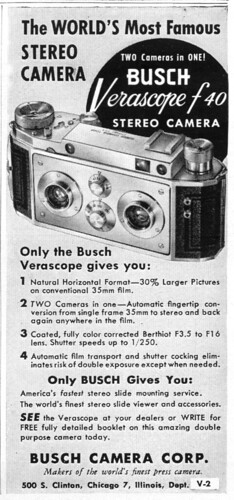Difference between revisions of "Verascope f40"
m (category deletion--cat with only one page) |
m (Noting a sighting of this camera in a '67 movie) |
||
| Line 8: | Line 8: | ||
The f40 was exported to the US where it was sold by the Chicago press-camera manufacturer [[Busch]]. | The f40 was exported to the US where it was sold by the Chicago press-camera manufacturer [[Busch]]. | ||
| + | |||
| + | This camera can be seen in use briefly in the 1967 film ''Two For The Road''<REF>Most clearly, starting at around 19:40 in the DVD edition. Alfred Finney plays a young architect, who tells Audrey Hepburn's character that his stereo camera is "mostly for buildings." (In fact, subjects near infinity would benefit little from 3-D photography.) The POV shots through the camera viewfinder are not realistic, as the framelines shown correspond to a widescreen [http://en.wikipedia.org/wiki/Panavision Panavision] [[aspect ratio]] instead.</REF>. | ||
| + | |||
| + | |||
| + | == Notes == | ||
| + | <references/> | ||
[[Category:Stereo]] [[Category:35mm stereo]] | [[Category:Stereo]] [[Category:35mm stereo]] | ||
Revision as of 02:46, 19 October 2012

|
| Busch advertisement in February, 1952 Popular Photography scan by Voxphoto (Image rights) |
The Verascope f40 was introduced about 1938, and was designed to take pairs of 24 x30mm images on 35mm film. This superseded the earlier Richard Verascope glass-plate models. Model f40 production continued through the 1950s, going through several small revisions. It is considered to be one of the better-finished stereo cameras made, though perhaps behind to the Stereo Realist.
The f40 was exported to the US where it was sold by the Chicago press-camera manufacturer Busch.
This camera can be seen in use briefly in the 1967 film Two For The Road[1].
Notes
- ↑ Most clearly, starting at around 19:40 in the DVD edition. Alfred Finney plays a young architect, who tells Audrey Hepburn's character that his stereo camera is "mostly for buildings." (In fact, subjects near infinity would benefit little from 3-D photography.) The POV shots through the camera viewfinder are not realistic, as the framelines shown correspond to a widescreen Panavision aspect ratio instead.